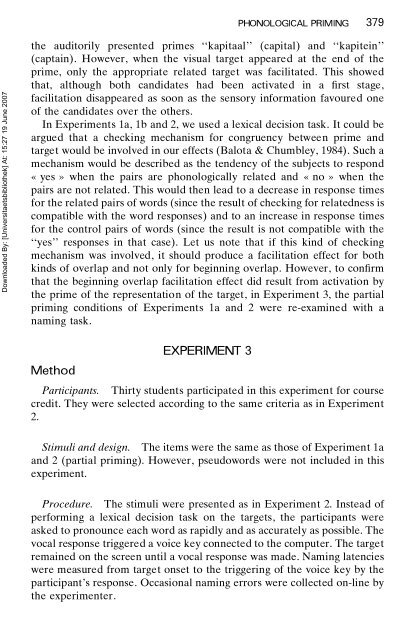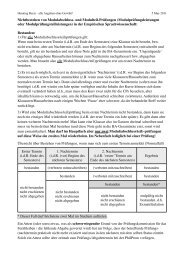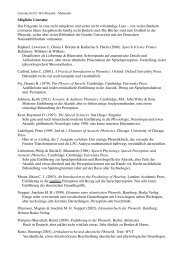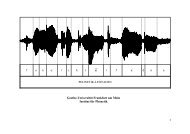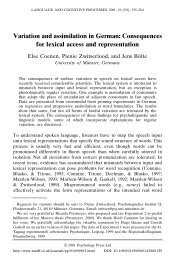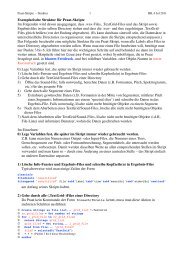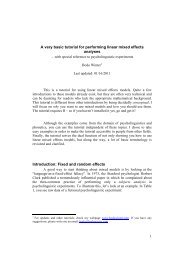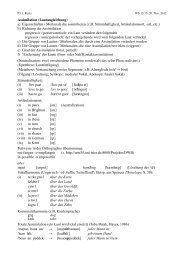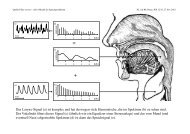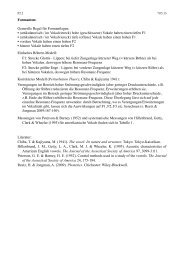Language and Cognitive Processes - Institut für Phonetik
Language and Cognitive Processes - Institut für Phonetik
Language and Cognitive Processes - Institut für Phonetik
Create successful ePaper yourself
Turn your PDF publications into a flip-book with our unique Google optimized e-Paper software.
Downloaded By: [Universitaetsbibliothek] At: 15:27 19 June 2007<br />
PHONOLOGICAL PRIMING 379<br />
the auditorily presented primes ‘‘kapitaal’’ (capital) <strong>and</strong> ‘‘kapitein’’<br />
(captain). However, when the visual target appeared at the end of the<br />
prime, only the appropriate related target was facilitated. This showed<br />
that, although both c<strong>and</strong>idates had been activated in a rst stage,<br />
facilitation disappeared as soon as the sensory information favoured one<br />
of the c<strong>and</strong>idates over the others.<br />
In Experiments 1a, 1b <strong>and</strong> 2, we used a lexical decision task. It could be<br />
argued that a checking mechanism for congruency between prime <strong>and</strong><br />
target would be involved in our effects (Balota & Chumbley, 1984). Such a<br />
mechanism would be described as the tendency of the subjects to respond<br />
« yes when the pairs are phonologically related <strong>and</strong> « no when the<br />
pairs are not related. This would then lead to a decrease in response times<br />
for the related pairs of words (since the result of checking for relatedness is<br />
compatible with the word responses) <strong>and</strong> to an increase in response times<br />
for the control pairs of words (since the result is not compatible with the<br />
‘‘yes’’ responses in that case). Let us note that if this kind of checking<br />
mechanism was involved, it should produce a facilitation effect for both<br />
kinds of overlap <strong>and</strong> not only for beginning overlap. However, to conrm<br />
that the beginning overlap facilitation effect did result from activation by<br />
the prime of the representation of the target, in Experiment 3, the partial<br />
priming conditions of Experiments 1a <strong>and</strong> 2 were re-examined with a<br />
naming task.<br />
Method<br />
EXPERIMENT 3<br />
Participants. Thirty students participated in this experiment for course<br />
credit. They were selected according to the same criteria as in Experiment<br />
2.<br />
Stimuli <strong>and</strong> design. The items were the same as those of Experiment 1a<br />
<strong>and</strong> 2 (partial priming). However, pseudowords were not included in this<br />
experiment.<br />
Procedure. The stimuli were presented as in Experiment 2. Instead of<br />
performing a lexical decision task on the targets, the participants were<br />
asked to pronounce each word as rapidly <strong>and</strong> as accurately as possible. The<br />
vocal response triggered a voice key connected to the computer. The target<br />
remained on the screen until a vocal response was made. Naming latencies<br />
were measured from target onset to the triggering of the voice key by the<br />
participant’s response. Occasional naming errors were collected on-line by<br />
the experimenter.


